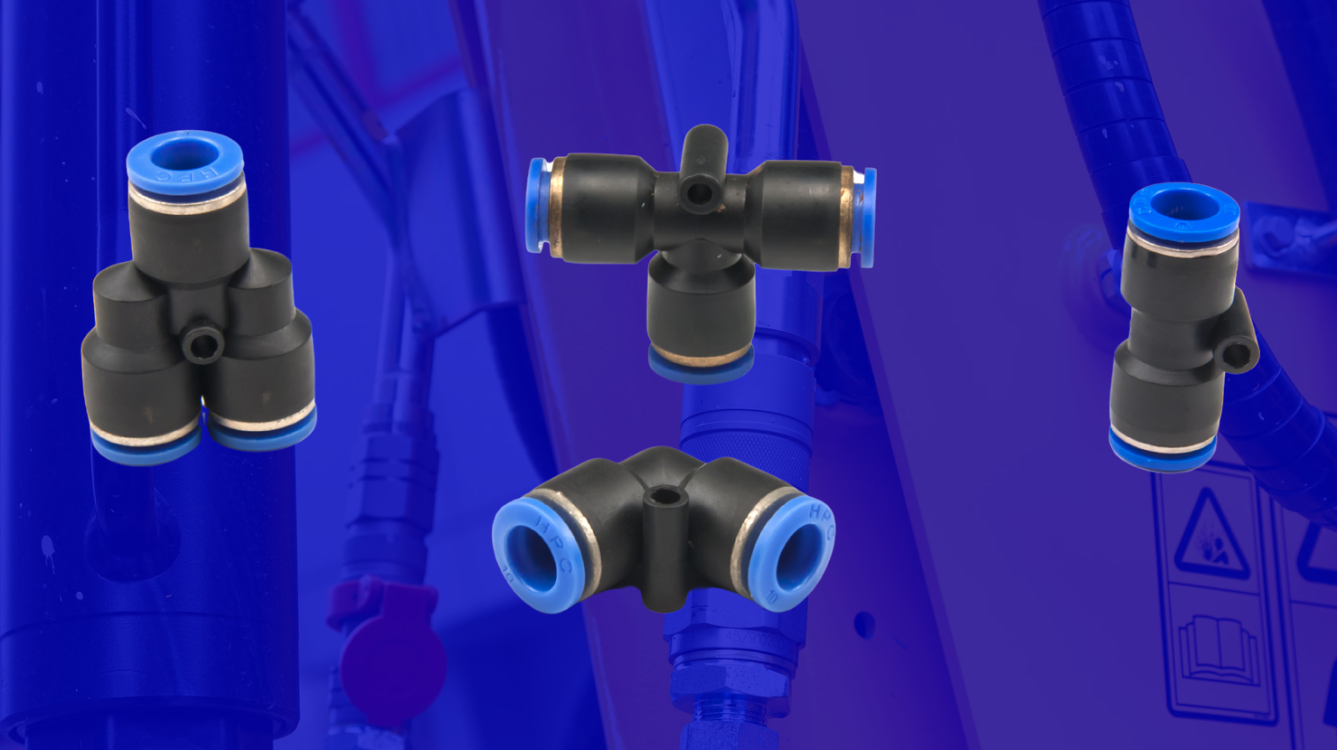Pneumatic Fittings - Everything You Need to Know About Air Fittings
by Quotebeam Team
Apr 3, 2024

In this guide on pneumatic fittings, we'll review everything you need to know about these essential components in pneumatic systems. From understanding what pneumatic fittings are to exploring their types and various connector fittings. we’ll also go over real-world examples of pneumatic connector fittings in industrial automation.
What are pneumatic fittings?
Pneumatic fittings are mechanical components used to connect pneumatic components such as hoses, tubes, and valves in compressed air systems. They play an important role in ensuring airtight connections and facilitating the transmission of compressed air between different parts of the system.
Types of Pneumatic Fittings
Let’s look into the different types of pneumatic fittings and when to use them:
- Push-to-Connect Fittings: Also known as quick-connect or push-in fittings, these fittings offer a convenient and efficient way to connect pneumatic components without needing tools. They feature a push-to-connect mechanism that allows tubing to be inserted easily into the fitting, creating a secure and leak-free connection. Push-to-connect fittings are ideal for applications where rapid installation and disassembly are required, making them commonly used in air fitting assemblies for pneumatic systems.
- Compression Fittings: Compression fittings consist of two parts: a compression nut and a ferrule. These fittings create a seal between the tubing and the fitting by compressing the ferrule against the tubing when the nut is tightened. Compression fittings are suitable for applications where high-pressure or vibration resistance is required, such as in air fitting connections for pneumatic cylinders or actuators.
- Barbed Fittings: Barbed fittings feature barbs or ridges on the fitting's surface, which grip onto the inside of the tubing when inserted. They are commonly used with flexible tubing and are ideal for low-pressure applications where a secure connection is needed but frequent disconnection is not required. Barbed fittings are often found in air fitting setups for pneumatic tools or equipment in industrial workshops.
- Threaded Fittings: Threaded fittings have threads on their exterior surface, allowing them to be screwed into matching threaded ports or fittings. They provide a reliable and leak-proof connection and are often used in applications requiring a high degree of precision or in environments with high temperatures or pressures. Threaded fittings are commonly utilized in air fitting assemblies for pneumatic control valves or regulators in industrial automation systems.
What are the Types of Pneumatic Connector Fittings?
Pneumatic connector fittings, including straight, elbow, tee, reducer, and bulkhead connectors, offer versatile solutions for connecting pneumatic components in industrial automation systems, accommodating different connection requirements, and enabling efficient routing and distribution of compressed air.
- Straight Connectors: Straight connectors are used to connect two pieces of tubing or components in a straight line. They come in various configurations, including push-to-connect, compression, barbed, and threaded, to accommodate different connection requirements.
- Elbow Connectors: Elbow connectors, also known as 90-degree connectors, allow for a change in direction in pneumatic systems. They are available in push-to-connect, compression, and threaded configurations, making them suitable for diverse applications with space constraints or routing considerations.
- Tee Connectors: Tee connectors are designed to split or join pneumatic lines into two or more directions. They come in push-to-connect, compression, and threaded variants, enabling versatile connections in pneumatic systems with multiple branches or outlets.
- Reducer Connectors: Reducer connectors are used to transition between tubing of different sizes or diameters. They feature different-sized openings on each end and are available in push-to-connect, compression, and threaded versions to accommodate various tubing sizes and connection methods.
- Bulkhead Connectors: Bulkhead connectors are designed to pass through panels or walls, providing a secure and sealed connection between pneumatic components on either side, ideal for applications where space constraints or environmental considerations are present.
Real-World Examples of Pneumatic Connector Fittings in Industrial Automation:
From assembly line robotics in automotive manufacturing to conveyor systems in food processing plants, let’s take a closer look at how pneumatic connectors fit in industrial automation.
- Push-to-Connect Fittings: Widely used in industrial automation, such as automotive manufacturing, for quick and tool-free installation in assembly line robots, enabling efficient setup and reconfiguration of robotic arms.
- Compression Fittings: Commonly employed in hydraulic and pneumatic systems, like in food processing plants, for secure and leak-proof connections in conveyor systems, ensuring smooth and hygienic operation critical for maintaining product quality and safety standards.
- Barbed Fittings: Found in industrial automation, especially in packaging machinery, for flexible and easy installation, allowing precise control and manipulation of packaging materials for efficient packaging operations.
- Threaded Fittings: Often utilized in industrial automation environments with high-pressure or high-temperature conditions, such as in manufacturing facilities, for robust and reliable sealing in compressed air distribution systems, essential for maintaining consistent air pressure and operation of automated machinery.
Pneumatic fittings are crucial for connecting components in compressed air systems, ensuring efficient operation. Understanding their types aids in selecting fittings tailored to specific needs, with options like push-to-connect, compression, barbed, or threaded fittings offering unique advantages. We hope this guide has provided valuable insights into their role in pneumatic systems.
